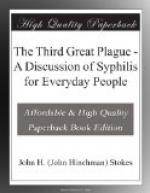+Antibodies in the Blood in Disease.+—It is part of the new understanding we have of many diseases that we are able to recognize them by finding in the blood of the sick person substances which the body makes to neutralize or destroy the poisons made by the invading germs, even when we cannot find the germs themselves. These substances are called antibodies, and the search for antibodies in different diseases has been an enthusiastic one. If we can by any scheme teach the body to make antibodies for a germ, we can teach it to cure for itself the disease caused by that germ. So, for example, by injecting dead germs as a vaccine in typhoid fever and certain other diseases, we are able to teach the body to form protective substances which will kill any of the living germs of that particular kind which gain entrance to the body. Conversely, if the body is invaded by a particular kind of germ, and we are in doubt as to just which one it is, we can identify it by finding in the blood of the sick person the antibody which we know by certain tests will kill or injure a certain germ. This sort of medical detective work was first applied to syphilis successfully by Wassermann, Neisser, and Bruck in 1904, and for that reason the test for these antibodies in the blood in syphilis is called the Wassermann reaction. To be sure, it is now known that in syphilis it is not a true antibody for the poisons of the Spirochaeta pallida for which we are testing, but rather a physical-chemical change in the serum of patients with syphilis, which can be produced by other things besides this one disease. But this fact has not impaired the practical value of the test, since the other conditions which give it are not likely to be confused with syphilis in this part of the world. The fact that no true antibody is formed simply makes it unlikely that we shall ever have a vaccine for syphilis.
+Difficulties of the Test.+—The Wassermann blood test for syphilis is one of the most complex tests in medicine. The theory of it is beyond the average man’s comprehension. A large number of factors enter into the production of a correct result, and the attaining of that result involves a high degree of technical skill and a large experience. It is no affair for the amateur. The test should be made by a specialist of recognized standing, and this term does not include many of the commercial laboratories which spring up like mushrooms in these days of laboratory methods.
+The Recognition of Syphilis by the Blood Test.+—When the Wassermann test shows the presence of syphilis, we speak of it as “positive.” Granted that the test is properly done, a strong positive reaction means syphilis, unless it is covered by the limited list of exceptions. After the first few weeks of the disease, and through the early secondary period, the blood test is positive in practically all cases. Its reliability is, therefore, greatest at this time. Before the infection has spread beyond the first sore,




